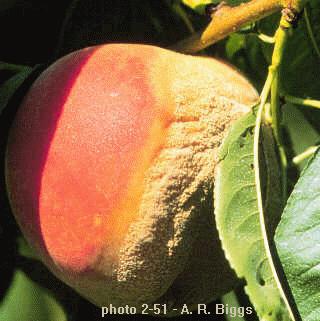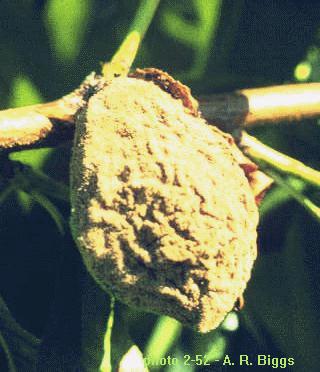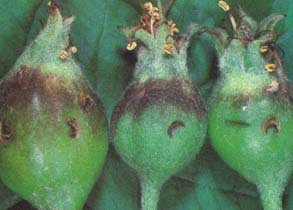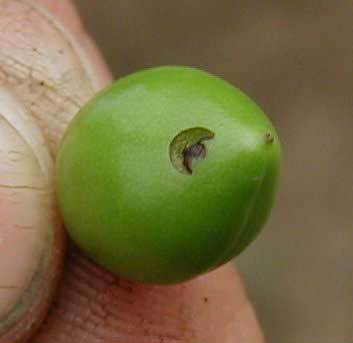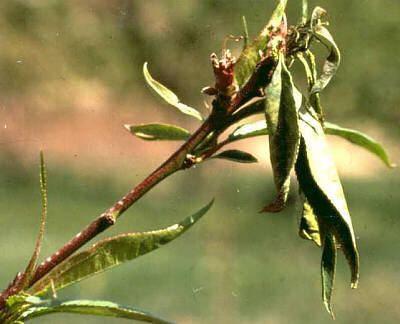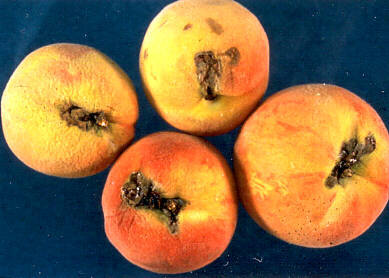
Peach and Apricot Trees:
Peach trees are grown throughout Texas. Apricot trees are not so common. What most people don't know is that both of these fruit trees also have chilling requirements, although it is less than many apple or pear trees, and apricot trees need more chill hours than peach trees. Apricot trees lowest range is zone eight, and won't produce fruit as far south as San Antonio. If you have a peach or apricot tree that has never successfully grown mature fruit, the reason may be that it is a variety that needs more chilling hours than it is getting.
Chilling hours is the number of hours the tree gets below 45 F between November and mid-February. You can figure it out yourself if you average the temperature of every day during this time for the last several years, or you can call your county extension agent. College Station gets about 500 chill hours each winter, and so I figure it is about the same here around Taylor. If the tree needs more than that, it just won't set fruit well here because it will bud out too late in the season and will it get too hot and dry for it. The fruit will set and then just drop off without maturing. Vice-versa, if it blooms too early, then the frost will get the blooms. It is better to have two varieties that bloom a few weeks apart, so hopefully, you'll have one producing tree each year. Call your county extension agent for recommendations of peach and apricot tree varieties that are known to do well where you live. Commercial orchards have to plan on losing two crops out of every seven years due to frost.
Peach trees are not long lived. They will be producing a full crop by their third year, yet die in the fourth or fifth year due to disease. This is especially the case if the trees were replanted where old peach trees died. You should wait four years before you replant an old orchard of peach trees. Peach trees are affected by more disease than apricot trees. There are some disease such as scale that is more predominant in wetter climates, so I will touch on only those that cause the most problems here. You can avoid many diseases of peach and apricot trees by choosing a good site to plant your trees. It will need to be in an airy place, the higher the ground the better. They do not like wet feet and if the drainage is poor are susceptible to root rots and nematodes. Peach and apricot trees also need fertile soil, and water during long dry spells. If it doesn't rain an inch during a month you will need to water it, and it needs a lot more during fruit development. Apricot trees are more drought hardy than peach trees, however. The need for an open site on high ground is because frost damage to a tree in bloom is more likely in a low site where the humidity is higher. Where the fog collects is where there will be the most frost.
The most damaging disease to peach development is brown rot. This is where the fruit is attacked during and after bloom time by a fungus called M. fructicola. The fruit will turn brown by mold and fall off the tree before they are fully ripe. The time to take care of it is when the tree is blossoming and throughout fruit development. There are several fungicide sprays available, so check this with your county agent also. Keep underneath the tree free from rotten fruit and weeds. If you are an organic grower there are not many fungicides available to treat this disease, but there are some. The disease is worst during wet humid weather.
These pictures of brown rot damage are from the West Virginia University website Kearneysville, WV.
Peach trees are grown throughout Texas. Apricot trees are not so common. What most people don't know is that both of these fruit trees also have chilling requirements, although it is less than many apple or pear trees, and apricot trees need more chill hours than peach trees. Apricot trees lowest range is zone eight, and won't produce fruit as far south as San Antonio. If you have a peach or apricot tree that has never successfully grown mature fruit, the reason may be that it is a variety that needs more chilling hours than it is getting.
Chilling hours is the number of hours the tree gets below 45 F between November and mid-February. You can figure it out yourself if you average the temperature of every day during this time for the last several years, or you can call your county extension agent. College Station gets about 500 chill hours each winter, and so I figure it is about the same here around Taylor. If the tree needs more than that, it just won't set fruit well here because it will bud out too late in the season and will it get too hot and dry for it. The fruit will set and then just drop off without maturing. Vice-versa, if it blooms too early, then the frost will get the blooms. It is better to have two varieties that bloom a few weeks apart, so hopefully, you'll have one producing tree each year. Call your county extension agent for recommendations of peach and apricot tree varieties that are known to do well where you live. Commercial orchards have to plan on losing two crops out of every seven years due to frost.
Peach trees are not long lived. They will be producing a full crop by their third year, yet die in the fourth or fifth year due to disease. This is especially the case if the trees were replanted where old peach trees died. You should wait four years before you replant an old orchard of peach trees. Peach trees are affected by more disease than apricot trees. There are some disease such as scale that is more predominant in wetter climates, so I will touch on only those that cause the most problems here. You can avoid many diseases of peach and apricot trees by choosing a good site to plant your trees. It will need to be in an airy place, the higher the ground the better. They do not like wet feet and if the drainage is poor are susceptible to root rots and nematodes. Peach and apricot trees also need fertile soil, and water during long dry spells. If it doesn't rain an inch during a month you will need to water it, and it needs a lot more during fruit development. Apricot trees are more drought hardy than peach trees, however. The need for an open site on high ground is because frost damage to a tree in bloom is more likely in a low site where the humidity is higher. Where the fog collects is where there will be the most frost.
The most damaging disease to peach development is brown rot. This is where the fruit is attacked during and after bloom time by a fungus called M. fructicola. The fruit will turn brown by mold and fall off the tree before they are fully ripe. The time to take care of it is when the tree is blossoming and throughout fruit development. There are several fungicide sprays available, so check this with your county agent also. Keep underneath the tree free from rotten fruit and weeds. If you are an organic grower there are not many fungicides available to treat this disease, but there are some. The disease is worst during wet humid weather.
These pictures of brown rot damage are from the West Virginia University website Kearneysville, WV.
The worst insect diseases for peach trees in this area are the Peach Twig Borer and the Plum Curculio. These pests are taken care of by spraying when the tree is not in bloom or you'll kill your pollinating insects and bees, also resulting in low fruit yields. You must spray for the Plum Curculio right after petal fall, so now that peach trees are in bloom call your county extension agent and get your stuff ready. The Plum Curculio Beetle lays her eggs on ripening fruit and the maturing munching larvae inside the ripening peaches will cause the fruit to fall off unmatured. The Peach Twig Borer causes branches to die back past the buds and break off. This pest is treated during the winter during dormancy and organic growers can use an oil spray for this to kill the overwintering adults on the tree. If you haven't done it already, wait until after petal fall and use a pesticide spray immediately.
These pictures of Plum Curculio Beetle damage are from the Michigan State University website, Van Buren Extension Office.
The pictures of Peach Twig Borer damage below are from the British Columbia, CA government website Ministry of Agriculture.
Well, I haven't touched upon pruning. It is best to prune all trees during dormancy to prevent less disease from entering the seeping wounds, but you are also pruning off the buds when you do it. Commercial orchards wait until pink bud stage before pruning because they are hoping that an early frost will leave them some flowers. A peach tree is pruned, like any other fruit tree. You cut out the middle so that light and air can reach the fruit, any crisscrossing branches, and leave one branch to grow up as a main trunk. Do not allow extra branches to be the main trunk as the excess leaves will block out the air, making the tree more susceptible to disease, and harder to treat.
So if everything goes well, you'll have more fruit maturing on the tree than the tree can handle, and you'll have to hand thin it or else the weight can break the branches and the fruit will be small. There you have the gist of growing peaches. Apricots are all the same except for the thinning part. The fruit is smaller, and you won't have to do that much at least.
Good luck, and have lots of peaches this summer! Let me know, and I'll come buy some of yours!
So if everything goes well, you'll have more fruit maturing on the tree than the tree can handle, and you'll have to hand thin it or else the weight can break the branches and the fruit will be small. There you have the gist of growing peaches. Apricots are all the same except for the thinning part. The fruit is smaller, and you won't have to do that much at least.
Good luck, and have lots of peaches this summer! Let me know, and I'll come buy some of yours!
